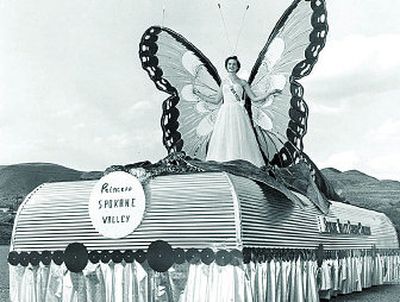Lack of a proper float rains on Valley’s parade

An odd question surfaced last week as Spokane Valley prepared to crown a new teenage “Miss.”
As she travels from town to town rubbing elbows with other pageant royalty and representing her city in various parades, will Spokane Valley’s new princess have to hitch a ride?
Three years ago, the city decided to revive its lost tradition of transforming one of its brighter, civic-minded high school juniors into the town princess for one year. It’s a coronation complete with a $1,000 scholarship for the winner and $500 each for the two runners-up. In return, the court must represent Spokane Valley at business events and parades in neighboring cities.
But despite the titles and tiaras, there’s no carriage. That is, there’s no float to get these girls around. Lately, they’ve been on the parade circuit in cars donated by dealer Marti Hollenback. Before that, there was no telling what they might show up in.
“Before Marti came on board this last year it was like ‘Planes, Trains and Automobiles,’ ” said Connie Wagner, a volunteer who does the heavy lifting for the Miss Spokane Valley pageant.
At one point, the community’s gowned ambassadors were riding around in the back of a pickup. Other times, they rode on a rented float. On the other hand, their peers from communities of all sizes rode around on floats, which some would argue is as natural as figurines on a wedding cake.
“It would be nice for them to have their own carriage,” said Peggy Doering, organizer of the community’s parade and Valleyfest, its only large community event.
She keeps a float magazine that reads like a Sears gift catalog tucked away in her desk and has an “I have a dream” sermon ready on the benefits of a community-built float, how it would bring people together and give residents a sense of pride.
It’s not like Spokane Valley never had a float. A half-century ago, princess sailed through parades on a metallic land yacht decorated with Kaiser aluminum. Standing still, the float looked faster than a speeding train. But community support for the float slowly lost momentum.
Two years ago, the Spokane Valley Chamber of Commerce asked the City Council to help bankroll a float with its hotel bed tax money. Because the tax of 2 percent is charged to overnight visitors at hotels, state law directs that it be used to attract tourism.
Could there be a better way to attract tourists than trolling your best young gals down small-town Eastern Washington’s main drags on a shimmering chrome-petaled barge? A lot of folks say no. There are at least 30 parades across Washington from April 14 through September featuring floats, according to the Washington Festival and Events Association. That would be more than one per weekend, except in some cases the parade dates overlap.
There are parades for rhododendrons, daffodils, lilacs, bald eagles, berries and milk. Parades for apple blossoms, lentils, farmers, fallen soldiers, and parades just because. Consequently, there’s a lot of reciprocal back scratching that goes on among the float set. The Fairfield folks roll out their float for the Lentil Festival in Pullman. The Pullman folks roll out their float for Flag Day in Fairfield. A community that’s all take and no give soon learns the difference between a parade and a lonely walk down the middle of the street.
The Chamber of Commerce estimated it “needed at least $15,000 to do this project.” The City Council offered $5,000 in late 2005. Since then, nothing’s materialized. Sources say chamber President Eldonna Shaw still would like to build a float, but she didn’t return calls to her office and cell phone last week.
Many small town float-builders get by without government help. Diehards, like Fairfield float architect Darlene Wernz, say they could build a pretty good float for $5,000.
“Yeah, I could do it,” said Wernz. “I think you could go to a place like Spalding’s and get the motor and the frame. Ours is a stripped down Volkswagen and Karmann Ghias are good, too. Tekoa’s is a Karmann Ghia.”
The 60-year-old Wernz and a close friend constructed Fairfield’s float with the help of friends and family. Initially, she bought her float and trailer used for $2,000 from folks in Colfax who were getting out of the business. The colorful barge renowned for its display of state and national flags has won multiple awards and been featured on promotional posters for a parade in another state.
Wernz covers Fairfield float costs by selling advertising NASCAR-style on the covered trailer in which the float is hauled to 10 or more parades each year, including the Fourth of July parade in Butte, 328 miles away.
Small communities building floats on a budget cut the gristle from an old car’s frame until all that’s attached are four tires, a steering wheel and the machinery that makes the car go.
The float frame is then welded, bolted or clamped to whatever is left.
Six miles south of Fairfield, parents in the Freeman School District assemble their float at the fairgrounds in Rockford. Their crew is a motley assembly of float diehards plus mothers and fathers of grade-school children who secured spots on the float by winning essay contests.
The Freeman float caveat is: If your child rides on the petaled barge, you help build it. Kids do their part by selling root beer “floats for the float” throughout the year, which townsfolk lap up for the good of the community. It’s a chicken-and-egg conundrum as to which came first, the community or the float, though most agree there wouldn’t be much of either, had the two not come together.